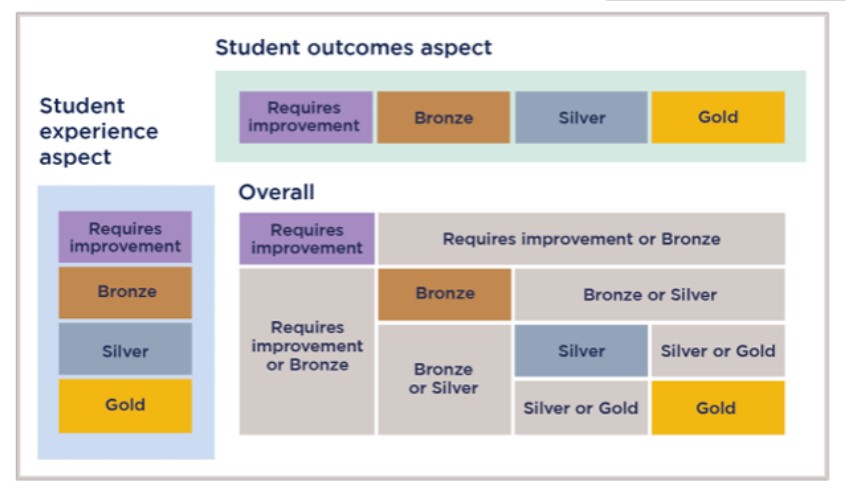The results have been published for the fifth iteration of the Teaching Excellence Framework.
The Teaching Excellence Framework (TEF) is an Office for Students (OfS) managed way of rating teaching quality using proxy metrics, provider submissions, and student submissions. The main awards providers can get are bronze, silver, and gold. Here’s how everyone got on:
[Full results]
These, however, are not the final results – some 53 providers (23 per cent of those involved) are marked with results “pending”. This is because the award offered to an institution is subject to appeal – results here will be published when available.
What we currently have is:
- 228 provider awards, at either gold (46), silver (100) , bronze (29) – or a “needs improvement” (0) rating
- Similar sub-awards (aspects) for student outcomes and student experience. These awards make up the main award via a formula
- And 53 “pending” awards – this indicates where an appeal is in progress. In these cases we don’t get details of awards.
What we will get later is:
- Panel statements (November)
- Provider submission (November)
- Student submission (November)
- Results of appeals (when available)
Forget everything else you may know about TEF – it’s all changed.
TEF awards are based on assessment by an expert panel. Members are expected to familiarise themselves with the context of a provider, before examining evidence (provider and student – usually the students’ union or similar – submissions, and one of eight metrics) and spotting “very high quality” (materially above expectations/ in line with benchmarks) or “outstanding quality” (among the best in the sector/materially above benchmarks/very high benchmark) features. Initial impressions are then moderated in discussion by the wider panel.
Though panel members will start with overall metrics and the submissions, they will have drilled down to split metrics where appropriate. Even so, the indicators should contribute no more than half of the evidence for each aspect. This is a huge difference from previous rounds of TEF, where metrics were used to assign an initial award with submissions and panel judgement having very limited impact at the margins)
What’s an aspect? Well – TEF now contains two “mini TEFs” – one covering student experience (the NSS metrics plus evidence from submissions) and the other covering student outcomes (continuation, completion, progression, plus evidence from the submissions. You get an award for each, which are then combined into your main TEF award. Here’s how that works:

A couple of further wrinkles – TEF is now an all-in once every four years event (though OfS can strip you of an award if you are naughty), and it is now possible to “fail” TEF by getting a “requires improvement” – which then punts you into the enforcement end of regulation. In England and award (gold, silver, bronze) still (technically) allows you to make an inflationary fee rise, but this relies on ministers raising the fee cap.
On awards day we get the two aspects awards, and the main award for each provider. We have to wait till November for a summary panel statement, the provider submission, and the student submission. If a provider has appealed the panel judgement the rating will be announced as “pending” – it will be properly announced when it is available.
The indicators and metrics are not as important this year, but here’s some dashboards to play with
[Overall metrics sector comparison]
[Split metrics sector comparison]
Super nerdy detail
You actually get what amounts to the marking criteria in annex A of the guidance, giving minimum requirements (based on the B conditions of registration), outstanding quality features, and very high quality features. The student outcomes aspect also talks about both B3 metrics and “educational gains” – these latter are based entirely on provider evidence (both in terms of articulating expected gains and demonstrating how they are met) – the intention is that eventually standard ways of measuring these gains will emerge as TEF iterates.



‘And 23 “pending” awards’
This seems to be a typo for 53.
Thanks. Fixed.
I don’t understand how a regulator who regulates to a baseline can *require* improvement *above* the baseline. As Shirley Pearce writes elsewhere, today, what is the process for monitoring this required improvement? Or does the process and language matter less than that the regulator is seen to be seeming to be doing something?
My reading is that TEF is an Excellence Framework, to stay on the OfS register you need to meet the baseline only (B conditions) but TEF is an extra gong above that (and a financial reward of £250 higher tuition fees per student). The panel judgement is that it ‘requires improvement’ to get the gong, not to meet the OfS baseline. The TEF process is compulsory, but the outcome is non-regulatory (allegedly). However the relationship between the B conditions (B3 particularly) and TEF is I think deliberately fuzzy! In PDR language these are our sector ‘stretching targets’ not just meeting our job description.